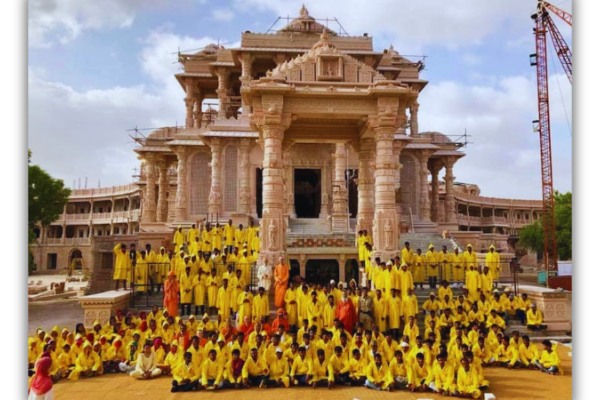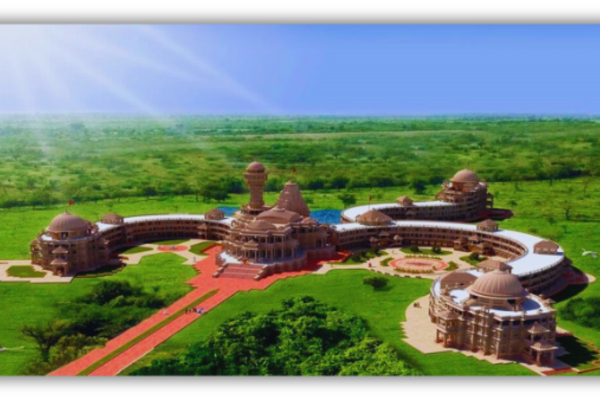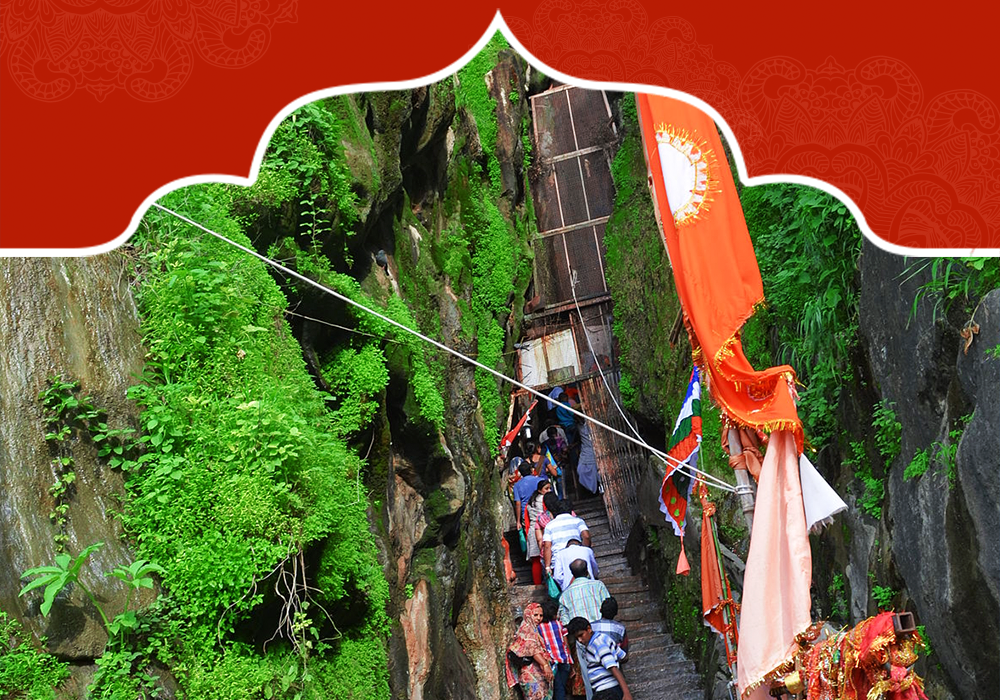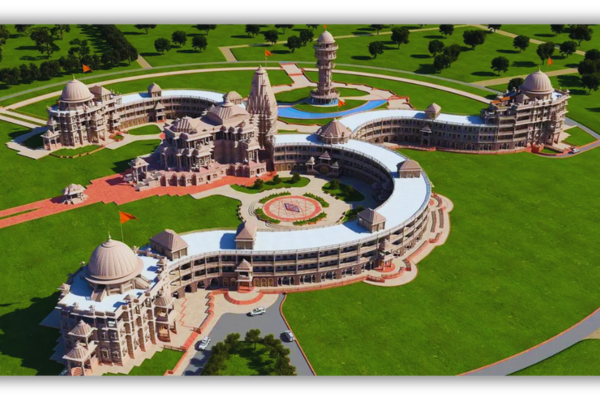The world’s first Om shaped temple has been inaugurated in Rajasthan’s Pali district, marking a significant milestone in architectural innovation and spiritual symbolism. Designed entirely in the shape of the sacred Om symbol, this temple blends traditional Hindu architectural principles with modern aesthetics. Situated amidst the serene landscapes of Pali district, it promises to be a unique spiritual and cultural landmark, attracting devotees and visitors from around the world. This description succinctly conveys the essence of the world’s first Om shaped temple in Rajasthan’s Pali district, emphasizing its groundbreaking architectural design and cultural significance worlds’s first om shaped temple.
1. Architectural Marvel.
The worlds’s first om shaped temple is a testament to creative ingenuity and meticulous craftsmanship. Every aspect of its design, from the sprawling layout to the intricate detailing, reflects deep-rooted spiritual symbolism. The temple’s contours mirror the sacred Om symbol, revered in Hinduism as the primordial sound of the universe and a symbol of divine energy.
2. Cultural Significance.
This temple inauguration marks a significant cultural milestone, not only in Rajasthan but globally. It serves as a beacon of religious harmony and cultural pride, attracting visitors from diverse backgrounds to experience its spiritual ambiance. Situated amidst the serene landscapes of Pali district, the temple offers a tranquil sanctuary for prayer, meditation, and reflection worlds’s first om shaped temple.
3. Symbolism and Spiritual Essence.
The worlds’s first om shaped temple,Om symbol, intricately integrated into the temple’s architecture, signifies the unity of existence and the cosmic connection between the individual soul (Atman) and the universal consciousness (Brahman). Its design elements, including the central sanctum and surrounding pathways, are crafted to enhance the spiritual journey of devotees who visit to seek solace and divine blessings.
4. Future Prospects.
Anticipated to become a major pilgrimage site and tourist attraction, the Om-shaped temple is poised to bolster tourism in Rajasthan’s Pali district. Its inauguration ceremony was attended by religious leaders, dignitaries, and enthusiasts alike, underscoring its importance in both religious and architectural spheres worlds’s first om shaped temple.

1. Features of the - worlds's first om shaped temple:
1. Architectural Design:-
- Om Shape: The entire temple is designed in the shape of the Om symbol, reflecting meticulous craftsmanship and attention to detail worlds’s first om shaped temple.
- Symbolic Elements: Each curve and angle of the temple’s design embodies the philosophical essence of Om, symbolizing creation, existence, and the ultimate reality.
2. Location and Setting:
- Pali District, Rajasthan: Situated amidst the serene landscapes of Rajasthan’s Pali district, the temple offers a tranquil setting conducive to spiritual reflection and worship.
- Scenic Surroundings: Surrounded by natural beauty, the temple enhances the spiritual experience of visitors and devotees alike.
3. Cultural and Religious Significance:
- Promotion of Harmony: The temple serves as a symbol of religious harmony, bringing together devotees and spiritual seekers from diverse backgrounds.
- Cultural Heritage: It contributes to Rajasthan’s rich cultural heritage, celebrating the state’s architectural ingenuity and spiritual traditions.
4. Inauguration and Celebration:
- Historic Event: The inauguration ceremony was a momentous occasion, attended by religious leaders, dignitaries, and enthusiasts celebrating the temple’s cultural and spiritual significance.
- Community Engagement: The temple inauguration fostered community spirit and pride, reinforcing its role as a cultural landmark worlds’s first om shaped temple.
5. Visitor Experience:
- Spiritual Retreat: Visitors experience a sense of peace and tranquility as they explore the temple’s sacred spaces and engage in prayers and rituals.
- Architectural Marvel: Admirers of architecture marvel at the innovative design and structural integrity of the Om-shaped temple, a blend of tradition and modernity.
6. Future Impact and Sustainability:
- Tourism Boost: Anticipated to become a major tourist attraction, the temple is expected to boost tourism in the region, supporting local economy and infrastructure development.
- Environmental Consciousness: Efforts are made to ensure the temple’s construction and operation are environmentally sustainable, respecting the surrounding ecosystem.
2. key points of worlds's first om shaped temple:
- Unique Design:- The temple is shaped in the form of the sacred Om symbol, a central spiritual icon in Hinduism symbolizing the universe and ultimate reality.
- Symbolic Significance:- Every architectural detail reflects the deep spiritual meaning of Om, enhancing the temple’s religious sanctity and cultural relevance.
- Cultural Integration:- It serves as a symbol of cultural pride and religious harmony, attracting visitors from diverse backgrounds to experience its spiritual ambiance.
- Architectural Innovation:- Combining traditional Hindu architectural elements with contemporary design, the temple represents a blend of ancient wisdom and modern creativity worlds’s first om shaped temple.
- Tourist Attraction: – Expected to boost tourism in Rajasthan’s Pali district, the temple offers visitors a unique architectural marvel and a serene spiritual retreat.
- Community Impact: – It fosters community engagement through religious ceremonies, cultural events, and educational programs, enriching the local cultural landscape.
- Environmental Considerations:- Designed with sustainable practices in mind, the temple promotes eco-friendly construction and maintenance methods.
- Educational Role:- Exhibitions and educational displays within the temple educate visitors about Hindu philosophy, mythology, and the significance of the Om symbol.
- Global Appeal: – The temple’s inauguration has garnered international attention, highlighting India’s cultural heritage and architectural prowess on a global stage worlds’s first om shaped temple.
- Future Development: – Plans for future expansions and enhancements aim to further elevate the temple’s status as a spiritual and cultural landmark.
3. Symbolism of Om in Hinduism
- The Om symbol holds profound significance in Hinduism, representing the essence of the universe and the ultimate reality. Here are the key aspects of its symbolism:-
- Universal Sound:- Om is considered the primordial sound from which all creation emerged. It symbolizes the cosmic vibration that permeates the entire universe, encompassing past, present, and future.
- Representation of Trinity:- Om embodies the three main aspects of the divine in Hinduism:
- A (अ) represents creation (Brahma), signifying the beginning and birth of all existence.
- U (उ) symbolizes preservation (Vishnu), representing the life-sustaining force that maintains the universe.
- M (म्) signifies destruction or transformation (Shiva), reflecting the cyclical nature of existence and the eventual dissolution of the universe.
- Symbol of Unity:- Om signifies the unity of the individual soul (Atman) with the universal soul (Brahman). Chanting Om is believed to align one’s consciousness with the cosmic consciousness, fostering spiritual connection and enlightenment.
- Sacred Symbol in Rituals:- Om is integral to Hindu rituals and prayers, where it is chanted at the beginning and end of spiritual practices. It is also used in meditation to achieve a state of deep concentration and inner peace.
- Visual Representation:- The written form of Om in Devanagari script (ॐ) is visually striking and is often seen inscribed on temples, scriptures, and religious artifacts. Its circular shape symbolizes the eternal cycle of life, death, and rebirth.
- Philosophical Depth: – Om represents the union of mind, body, and spirit, emphasizing the harmony between the physical and metaphysical realms. It encapsulates the entirety of existence and the pursuit of spiritual awakening.
- Mantra of Enlightenment:- Chanting Om is believed to purify the mind and cleanse negative energies, leading to spiritual growth and self-realization. It is a powerful mantra that invokes inner peace and divine consciousness.

4. names of the 12 Jyotirlingas of Lord Shiva
| Jyotirlinga Name | Location | State |
|---|---|---|
| 1.Somnath Jyotirlinga | .Prabhas Patan, Gujarat | Gujarat |
| 2.Mallikarjuna Jyotirlinga | .Srisailam, Andhra Pradesh | Andhra Pradesh |
| 3.Mahakaleshwar Jyotirlinga | .Ujjain, Madhya Pradesh | Madhya Pradesh |
| 4.Omkareshwar Jyotirlinga | .Mandhata Island, Madhya Pradesh | Madhya Pradesh |
| 5.Kedarnath Jyotirlinga | .Kedarnath, Uttarakhand | Uttarakhand |
| 6.Bhimashankar Jyotirlinga | .Pune, Maharashtra | Maharashtra |
| 7.Kashi Vishwanath Jyotirlinga | .Varanasi, Uttar Pradesh | Uttar Pradesh |
| 8.Trimbakeshwar Jyotirlinga | .Trimbak, Maharashtra | Maharashtra |
| 9.Vaidyanath Jyotirlinga | .Deoghar, Jharkhand | Jharkhand |
| 10.Nageshwar Jyotirlinga | .Dwarka, Gujarat | Gujarat |
| 11.Rameshwar Jyotirlinga | .Rameswaram, Tamil Nadu | Tamil Nadu |
| 12.Grishneshwar Jyotirlinga | .Ellora, Maharashtra | Maharashtra |
5. Visitor Information-
Opening Hours and Entry Fees
The Om-shaped temple in Pali district welcomes visitors from 6 AM to 9 PM daily. Entry to the temple is free for everyone, although donations are appreciated to support the maintenance and further development of the temple facilities. For those interested in learning more about the temple’s rich history, architecture, and spiritual significance, special guided tours are available. These tours provide visitors with in-depth insights and are particularly beneficial for groups.
Safety and Security
Ensuring the safety of all visitors is a top priority at the temple. The premises are equipped with modern safety features including surveillance cameras and a comprehensive emergency response system. Trained security personnel are present to provide assistance and maintain a secure environment, allowing visitors to enjoy their time at the temple with peace of mind.
Accessibility
The Om-shaped temple is committed to being accessible to all. Ramps and elevators are available throughout the complex, making it convenient for people with disabilities to navigate the temple grounds. Additionally, there are designated parking spaces and rest areas to accommodate visitors with special needs.
Facilities and Amenities
The temple complex offers a range of amenities to enhance the visitor experience:
- Restrooms: Clean and well-maintained restrooms are available throughout the temple grounds.
- Drinking Water: Safe drinking water stations are strategically placed for visitor convenience.
- Prayer and Meditation Areas: Designated areas for prayer and meditation provide a peaceful environment for spiritual activities.
- Souvenir Shops: Visitors can purchase souvenirs and religious items from shops located within the temple complex.
Guidelines for Visitors
To ensure a respectful and pleasant experience for everyone, visitors are requested to adhere to the following guidelines:
- Dress Code: Modest attire is recommended. Visitors should avoid wearing revealing clothing.
- Behavior: Respectful behavior towards the temple, its deities, and fellow visitors is expected at all times.
- Photography: Photography is allowed in designated areas. Visitors are requested to respect signs indicating no-photography zones.
- Mobile Phones: Use of mobile phones should be limited in prayer and meditation areas to maintain a serene atmosphere.

- By Road - Well-connected by road, the temple can be reached via private vehicles, taxis, or buses. Ample parking space is available for visitors.
- By Train: - The nearest railway station is Pali Marwar, which is well-connected to major cities. From the station, visitors can hire a taxi or take a local bus to reach the temple
- By Air - The nearest airport is in Jodhpur, approximately 70 kilometers away. From the airport, visitors can take a taxi or a bus to the temple
- By Car - If you are driving, you can use Google Maps or a similar navigation tool to get directions to Pali. The town is accessible from major cities in Rajasthan.

Ranakpur Jain Temple

Jawai Dam and Leopard Safari

Somnath Temple

Parshuram Mahadev Temple
| City | Distance (km) | Approximate Travel Time |
|---|---|---|
| Jodhpur To Om Temple Pali Distance | 75km | 1.hours |
| Udaipur To Om Temple Pali Distance | 150km | 3 hours |
| Jaipur To Om Temple Pali Distance | 320km | 5. hours |
| Mount Abu To Om Temple Pali Distance | 160km | 3 hours |
| Ajmer To Om Temple Pali Distance | 200km | 4 hours |
| Pushkar To Om Temple Pali Distance | 180km | 3.5 hours |
| Jaisalmer To Om Temple Pali Distance | 350km | 6. hours |
| Ranakpur To Om Temple Pali Distance | 90km | 2 hours |
| Osian To Om Temple Pali Distance | 65km | 1.5 hours |
The Om-shaped temple in Pali district is not just a spiritual landmark but a perfect starting point to uncover the hidden treasures of Rajasthan. While visiting this architectural wonder, you can embark on a journey to explore the state’s diverse attractions. From the majestic forts of Jodhpur to the serene lakes of Udaipur, the temple’s location offers easy access to some of Rajasthan’s most captivating destinations. Whether you’re drawn to the historical grandeur of Jaipur, the cool retreat of Mount Abu, or the tranquil beauty of Pushkar, each city is within reach for an unforgettable adventure.
Dive into the vibrant culture, rich heritage, and stunning landscapes of Rajasthan, and let your visit to the Om Temple be the gateway to discovering the many wonders this incredible region has to offer.





